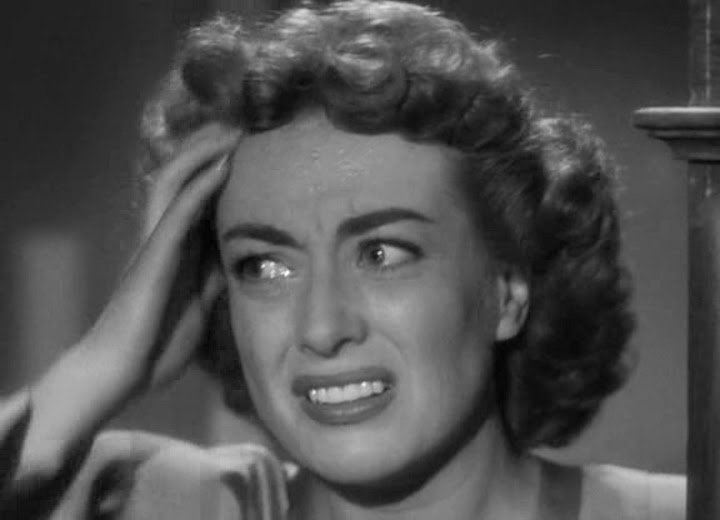Curtis Bernhardt, 1947
Starring: Joan Crawford, Van Heflin, Raymond Massey, Geraldine Brooks
After wandering around the city with amnesia and only able to mutter the name, “David,” a very sick woman is admitted to the psychiatric wing of a hospital. As she recovers, a doctor helps her recount her story. She became a nurse for the Graham family and the invalid Mrs. Graham. She had a relationship with one of their neighbors, an engineer named David, but he broke things off after she became obsessive. Meanwhile, the disturbed Mrs. Graham drowns in the lake, presumably suicide. Graham keeps Louise on to care for his children, but soon falls in love with her and proposes marriage. She agrees, although she does not love him, but hopes it will help her get revenge on David. Sometime later, David comes back into their lives due to a work contract, and develops a relationship with Carol, Louise’s new stepdaughter. Louise’s obsession with him renews and she slowly becomes more and more unhinged…
This strange blend of melodrama and film noir is an unusual entry in ‘40s cinema. It bears something in common with The Letter, Nora Prentiss, and Mildred Pierce, but is a convincing portrayal of one woman’s descent into madness. Joan Crawford was nominated for an Academy Award for Best Actress for her incredibly strong performance. She spent time interviewing psychiatrists and observing mental wards, which went wrong when one woman later sued Crawford and Warners Bros. The woman did not consent to Crawford and a few other studio people observing her electroshock therapy treatments.
Crawford’s Louise is the ultimate representation of the confusion — and mania — surrounding changing gender roles in the wartime and postwar worlds. In addition to her somewhat subservient, traditional occupation as a nurse, she longs for a traditional romantic role and wants David to marry her. He blames his profession and desire to move around from place to place, a literal way to avoid settling down. Like the film noir hero, he remains single and there is something unlikable about him, something not entirely masculine. Van Heflin (The Strange Love of Martha Ivers) is fittingly smarmy as David. The line between his complicity in Louise’s behavior is pleasantly blurred, making his role in the film less cut and dried.
Raymond Massey gives a solid performance, but his character — Mr. Graham — is as baffling as all the others. Why does he love Louise? Why does he insist on marrying her even though he knows she doesn’t love him? To the film’s credit, she does seem to warm up and begin to enjoy their life — he is a stable, positive contrast to David — but David’s constant appearance and her mania banishes this fleeting marital bliss. There is also a chilling air of manic depression about her interest in dining and dancing with her husband; her sudden, unexpected highs are simply too high, not believable.
The script leaves many questions unanswered and introduces too many ideas. For starters, Mrs. Graham’s suicide out on the lake makes this feel like a film noir and murder mystery, particularly with the eerie lake setting. Nothing is resolved and it doesn’t go anywhere, which is a shame. Louise’s insanity is another unanswered question. It seems that there should be some past trauma intruding on her life, but this is never addressed. Her obsession with David and subsequent possessiveness is simply a fact in and of itself. The one benefit to giving few explanations to any of the events is that it gives the film a dream-like quality, almost a fever dream as Louise wanders in and out of sanity.
Though there are plenty of melodramatic elements, there is a lot of film noir mixed in. Noir elements include flashbacks, fog, stark lighting, odd angles, and POV shots. The bleak ending is not at all redemptive, but there is some small hope for Louise’s recovery. Her husband, bafflingly, continues to standby and support her even though she is catatonic, insane, and a murderess. Louise’s mental breakdown scenes are oddly reminiscent of climactic moments from The Two Mrs. Carrolls and The Spiral Staircase, when women are trapped at home during the middle of a violent thunderstorm. In the latter two films, they are being pursued by violent killers, where as Louise is only being terrorized by her own mind.
On a final note, Geraldine Brooks is very likable as Louise’s step-daughter Carol, who is at first angry and resentful, but quickly warms to Louise’s presence in her family home. There is a slight echo of Mildred Pierce, with the spoiled, resentful daughter, but Carol’s cheery, light-hearted personality is a nice contrast with Louise’s growing sense of paranoia. Also keep an ear out for Franz Waxman’s wonderful score with elements of the Theremin to make Louise seem even crazier. Possession is available on DVD and comes recommended, particularly for fans of women-centric films noir and movies about portrayals female madness. Crawford might not hold a candle to Gloria Swanson’s Norma Desmond, but she is excellent in this thoroughly unglamorous role nonetheless.
















